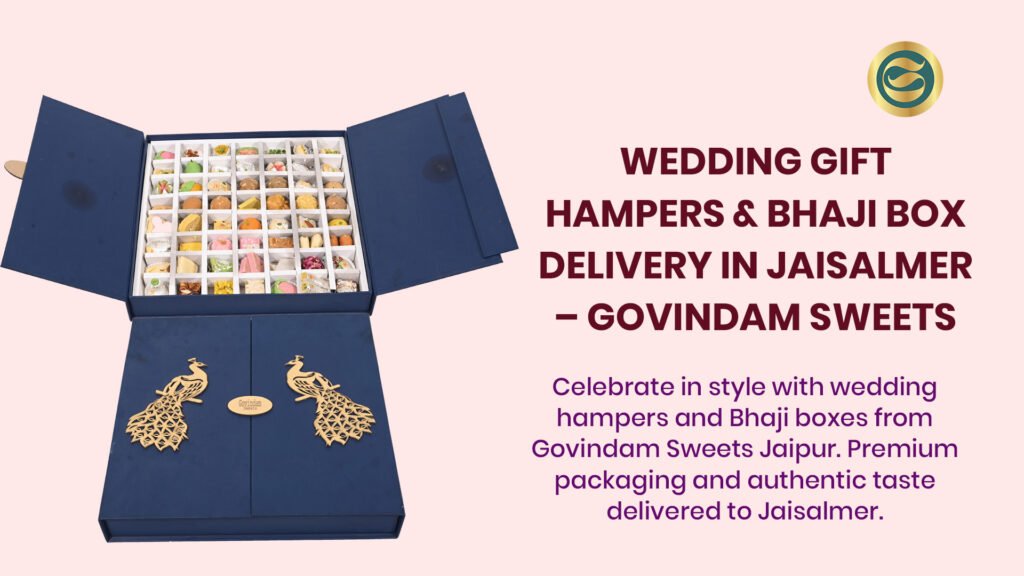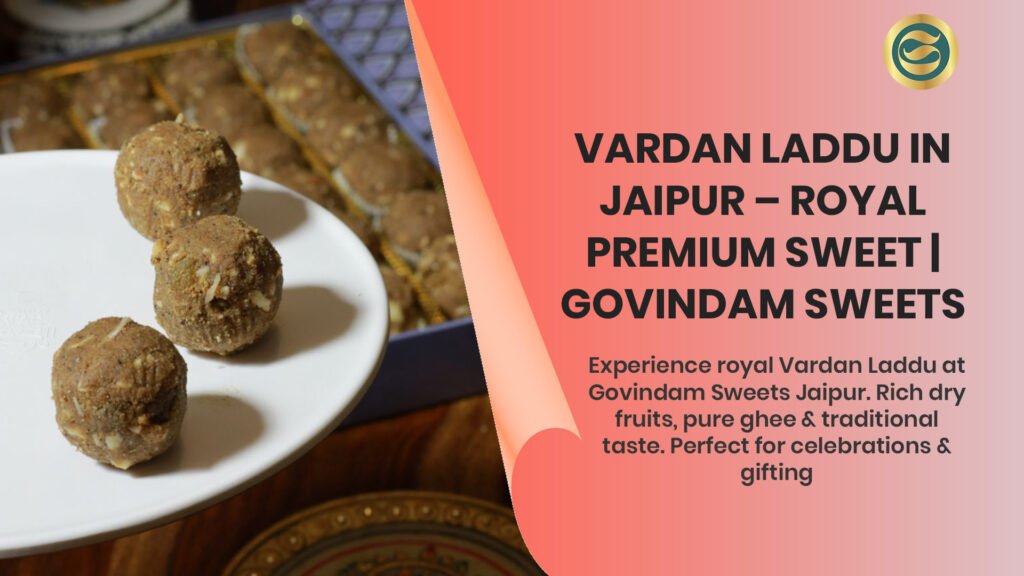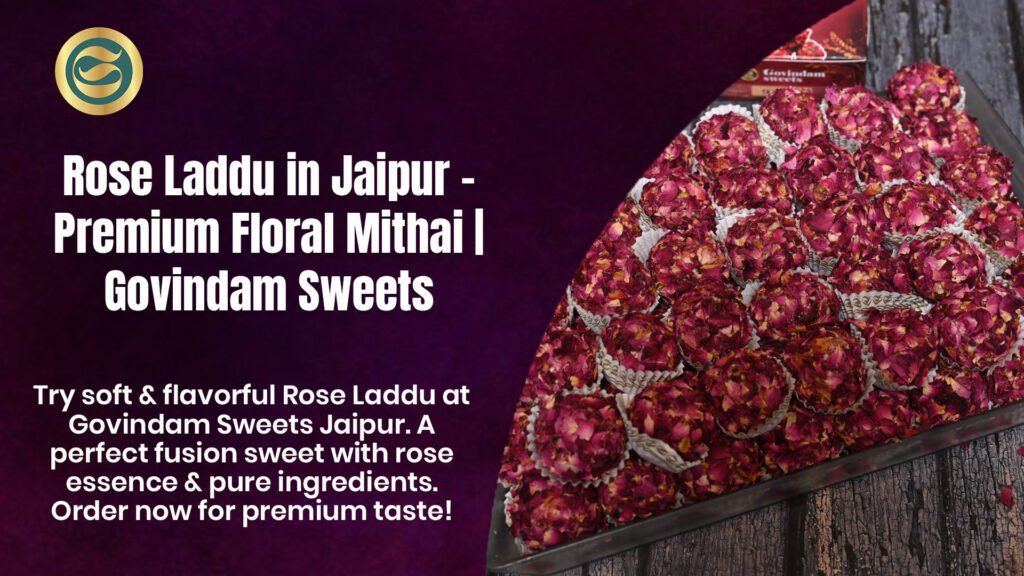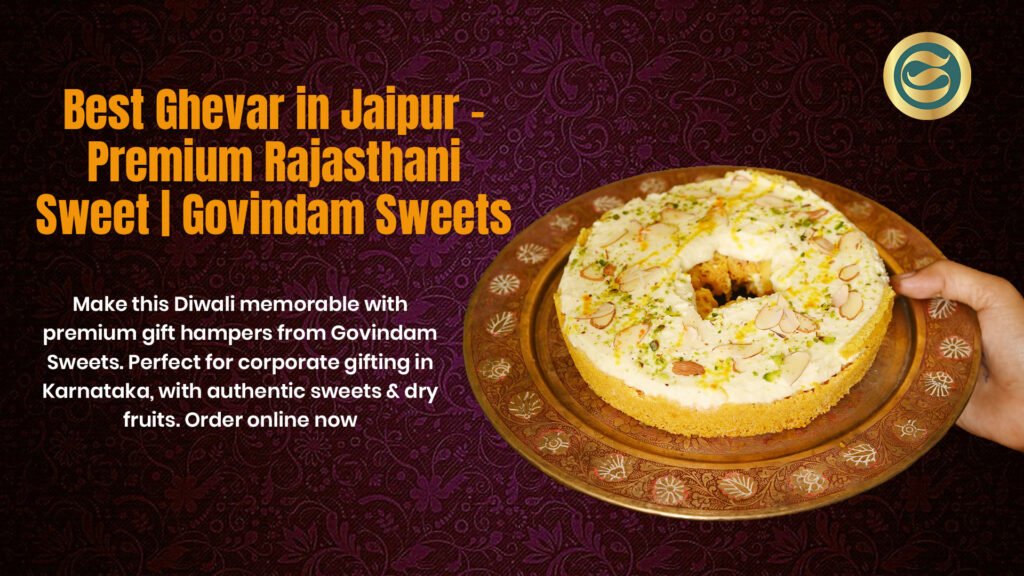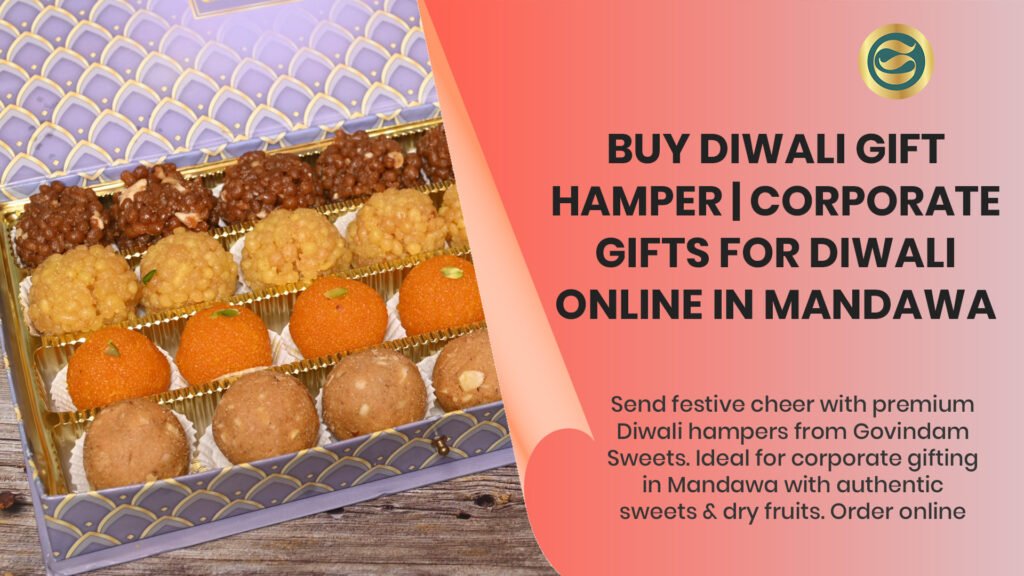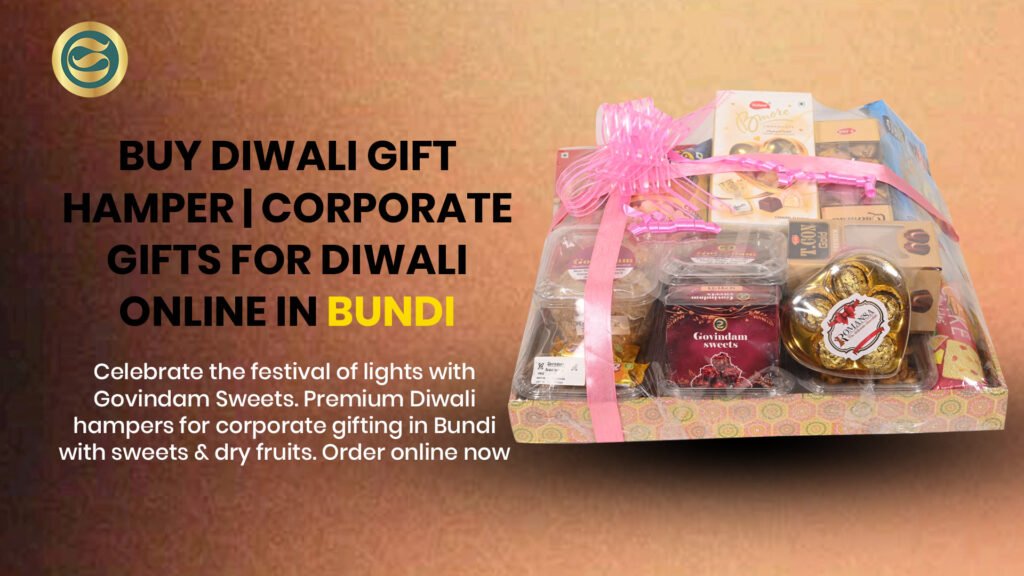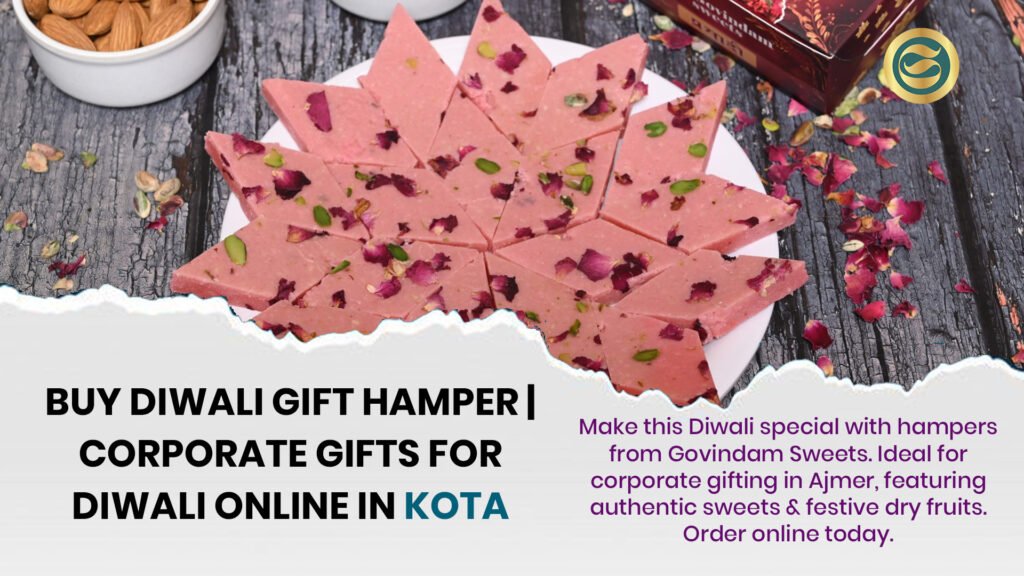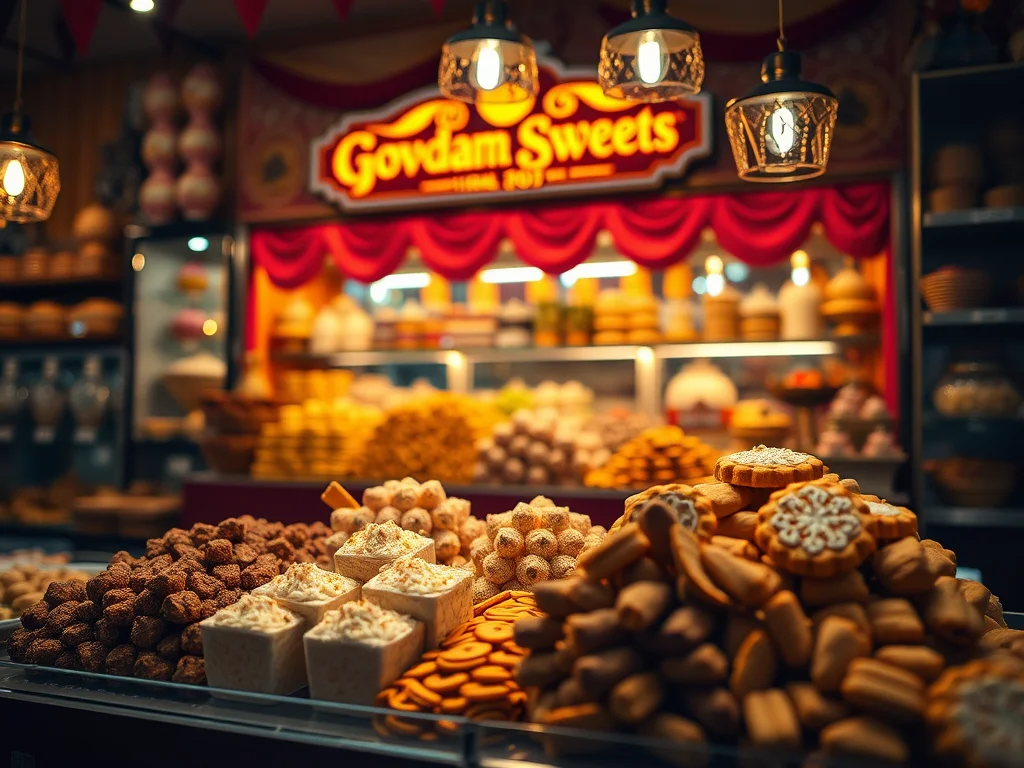
Posts
Traditional Doodh Laddu in Jaipur – Fresh & Pure | Govindam Sweets

Discover traditional Doodh Laddu in Jaipur at Govindam Sweets featuring authentic milk-based preparation, pure desi ghee, fresh quality ingredients, expert craftsmanship, and cultural heritage. Experience why discerning customers choose Govindam for premium milk laddu perfect for festivals, celebrations, religious offerings, and special occasions throughout year.
Traditional Doodh Laddu in Jaipur – Fresh & Pure | Govindam Sweets
Introduction: Pure Milk Sweet Heritage
Finding traditional Doodh Laddu in Jaipur represents quest for one of India’s most fundamentally pure sweet preparations—the milk-based spherical confection that religious ceremonies feature prominently, festival celebrations include reverently, and traditional households prepare lovingly due to simple ingredient purity, cultural significance, and wholesome character that minimal processing and recognizable components create. Govindam Sweets has earned reputation as trusted source for fresh and pure Doodh Laddu through uncompromising ingredient quality, authentic traditional preparation, systematic freshness management, and ethical practices that discriminating customers recognize as genuine benchmark distinguishing superior milk laddu from disappointing alternatives that proliferate across market attempting capitalize on this preparation’s cultural importance without matching quality investment, ingredient purity, or preparation integrity that authentic excellence demands.
The Doodh Laddu distinction that makes Govindam stand apart reflects multiple critical factors—our pure fresh milk usage without powder substitutions or quality compromises, our authentic desi ghee commitment refusing cheaper alternatives despite cost pressures, our traditional preparation technique requiring patient skilled execution preventing shortcuts that texture and taste compromise, our freshness priority ensuring optimal quality through systematic production scheduling and inventory rotation, our cultural respect understanding appropriate contexts and religious significance, and our transparent quality communication refusing misleading claims or exaggerated purity assertions that informed consumers appropriately question through ingredient verification and taste evaluation. This comprehensive guide to Jaipur’s traditional Doodh Laddu explores what makes this preparation culturally special, why quality variations exist dramatically between vendors, how traditional preparation technique creates distinctive superior character, which occasions particularly suit Doodh Laddu consumption and religious offering, and how customers throughout India can access genuine Govindam quality through convenient online ordering bringing authentic Jaipur excellence nationwide.
Understanding Doodh Laddu excellence requires appreciating both preparation simplicity—fundamentally milk, sugar, and ghee—and the substantial care that this minimalist formulation actually demands for optimal purity and satisfaction. The milk quality determining final taste character and texture since primary ingredient dominates entire profile, the proper milk reduction technique achieving correct consistency without scorching or uneven cooking, the sugar balance creating appropriate sweetness without excessive levels or crystallization issues, the ghee integration providing richness and traditional binding without greasiness or separation, the shaping expertise forming uniform spheres maintaining visual appeal, and the freshness maintenance ensuring consumption within proper timeframes all require systematic quality consciousness and preparation integrity that casual sweet-makers cannot maintain despite apparent simplicity that proper Doodh Laddu’s pure character belies through wholesome satisfaction that careful preparation creates.
At Govindam Sweets, our traditional sweet collection includes authentic Doodh Laddu alongside our signature Rajasthani specializations like Ghewar and Balwan Laddu—while Doodh Laddu represents pan-Indian preparation rather than specifically Rajasthani regional specialty, our quality standards, ingredient commitments, and preparation expertise apply consistently across all categories ensuring reliable satisfaction. This comprehensive exploration examines every dimension making traditional Doodh Laddu exceptional—from ingredient purity and preparation technique through cultural significance and religious appropriateness to quality indicators and purchasing guidance, creating complete understanding enabling informed decisions when seeking authentic milk laddu whether for religious offerings, festival celebrations, auspicious occasions, or wholesome traditional enjoyment appreciating pure simple ingredients that modern processed alternatives increasingly lack despite convenience or extended shelf life that quality and purity potentially compromise.
What Makes Doodh Laddu Special: Pure Ingredient Heritage
Cultural and Religious Significance
Purity Symbolism:
Doodh Laddu’s cultural importance stems from ingredient purity and simplicity:
Sattvic Food: Ayurvedic classification as pure wholesome food suitable for spiritual contexts Minimal Processing: Simple preparation maintaining ingredient integrity and recognizable components White Color: Visual purity symbolism important in religious and ceremonial contexts Milk Base: Dairy’s traditional auspicious status in Hindu culture and ceremonies Vegetarian Pure: Unquestionable vegetarian status without controversial ingredients
Religious Contexts:
Temple Offerings (Prasad): Common temple distribution sweet due to purity and appropriateness Home Puja: Household worship ceremonies featuring Doodh Laddu as offering Festival Observances: Various Hindu festivals including preparations in celebration feasts Life Ceremonies: Birth celebrations, namings, religious initiations requiring pure foods Fasting Foods: Post-fast breaking meals sometimes including milk-based sweets
Auspicious Occasions:
New Beginnings: Housewarmings, business inaugurations, new ventures requiring blessing foods Achievement Celebrations: Academic success, promotions, milestones marked with sweets Guest Hospitality: Traditional welcoming and honoring through sweet offerings Social Bonding: Community gatherings and relationship building through food sharing
Distinctive Preparation Characteristics
Simple Ingredient Profile:
Core Components:
- Fresh Milk: Primary ingredient providing base flavor and nutrition
- Sugar: Sweetening agent and binding component
- Desi Ghee: Traditional clarified butter adding richness and authentic character
- Cardamom: Subtle aromatic enhancement (optional in some variations)
- Minimal Additions: No complex spicing or elaborate enrichments
Purity Advantage:
This simplicity creates both appeal and quality differentiation:
Recognizable Ingredients: Consumers understanding exactly what they’re eating Allergen Transparency: Clear composition aiding dietary management Quality Dependency: Ingredient purity directly determining final satisfaction No Masking: Simple profile preventing quality problems hiding through complex flavoring Traditional Authenticity: Maintaining original character without modern modifications
Textural Character:
Ideal Doodh Laddu Texture:
- Soft tender bite without excessive hardness or crumbling
- Slight grainy milk solid texture from proper reduction
- Cohesive sphere maintaining shape without falling apart
- Pleasant mouthfeel coating tongue without excessive greasiness
- Clean dissolution without residue or waxy coating
Flavor Profile:
Taste Characteristics:
- Milk Dominance: Fresh dairy taste clearly prominent throughout
- Balanced Sweetness: Appropriate sugar level complementing milk flavor
- Ghee Richness: Subtle background ghee character adding depth
- Delicate Aroma: Light cardamom (if used) enhancing without overwhelming
- Clean Finish: Pleasant aftertaste without artificial or off-notes
Nutritional and Wholesome Perception
Wholesome Image:
Doodh Laddu benefits from positive nutritional perception:
Milk Nutrition: Calcium, protein, vitamins associated with dairy consumption Recognizable Ingredients: Whole food components rather than mysterious additives Traditional Preparation: Minimal processing preserving natural nutrient profiles Home-Style Character: Association with homemade preparation and grandmother’s care Childhood Memories: Nostalgic connections to traditional family food culture
Reality Check:
While nutritionally superior to some sweets:
Sugar Content: Still contains substantial sugar requiring moderation Calorie Density: Energy-dense preparation not unlimited-consumption food Balance Context: Occasional treat within overall balanced diet rather than health food Portion Awareness: Small quantities providing satisfaction without excess
Appropriate Positioning:
Traditional wholesome sweet for special occasions rather than daily snack or health supplement—appreciating cultural value, ingredient purity, and occasional enjoyment within comprehensive wellness frameworks that balanced moderation enables.
Why Govindam’s Doodh Laddu Represents Quality Excellence
Pure Fresh Milk Commitment
No Powder Substitutions:
Our authentic Doodh Laddu begins with genuine fresh milk:
Real Milk Usage: Full-fat fresh dairy milk rather than reconstituted powder alternatives Quality Standards: Proper milk sourcing from reliable suppliers with hygiene standards Daily Fresh: Recent milk without extended storage or quality degradation Natural Flavor: Fresh milk’s characteristic taste that powder cannot fully replicate Nutritional Integrity: Minimal processing preserving natural milk nutrients
Cost Implications:
Fresh milk costs substantially more than powder:
Price Differential: Fresh milk 2-3 times more expensive than equivalent powder Logistical Complexity: Refrigeration, quick usage, supplier coordination required Waste Risk: Shorter shelf life creating potential spoilage if demand miscalculated Quality Variability: Seasonal changes and supplier variations requiring management
Our commitment maintaining fresh milk usage despite these challenges reflects long-term quality priorities over short-term profit maximization that powder substitution might temporarily enable before customer dissatisfaction eventually undermines reputation and sustainable success.
Detection Difficulty:
Unfortunately, consumers often cannot easily distinguish fresh milk from powder in finished laddu through appearance alone—taste differences exist but require discriminating palates and comparative experience. This verification challenge enables dishonest vendors substituting powder without customer awareness, making trust and vendor reputation particularly important when purchasing milk-based preparations where ingredient integrity fundamentally affects authentic character despite detection difficulties.
Authentic Desi Ghee Usage
Pure Ghee Standards:
Traditional Clarified Butter: Real desi ghee without vanaspati or vegetable oil blending Characteristic Flavor: Distinctive ghee taste that substitutes cannot authentically replicate Cultural Authenticity: Traditional ingredient expectations in religious and cultural contexts Quality Source: Reliable ghee suppliers with proper preparation and storage standards No Adulteration: Pure product without mixing or extending with cheaper alternatives
Cost-Quality Balance:
Pure ghee represents significant expense:
Premium Pricing: Authentic ghee costs substantially more than hydrogenated vegetable fat alternatives Market Pressure: Competitive environment tempting cheaper substitution Profit Impact: Ingredient costs affecting margins and pricing positioning Quality Commitment: Maintaining standards despite financial pressures
Our ghee commitment reflects values prioritizing authentic traditional character and customer health over convenience or cost savings that ingredient compromises might provide temporarily before quality consciousness and informed consumers eventually recognize and reject such shortcuts.
Traditional Preparation Expertise
Milk Reduction Technique:
Patient Process:
- Slow simmering reducing water content while concentrating solids
- Continuous stirring preventing scorching and ensuring even cooking
- Temperature management maintaining proper heat without burning
- Endpoint recognition knowing exact moment when consistency optimal
- Texture development achieving proper grainy milk solid character
Skill Requirements:
- Experience-based judgment recognizing visual and textural cues
- Timing precision balancing efficiency with quality needs
- Problem-solving addressing variations in milk batches
- Consistency achievement producing uniform results across batches
Sugar Integration:
Proper Balance:
- Appropriate sweetness level complementing milk without overwhelming
- Syrup concentration enabling binding without excessive hardness
- Timing coordination adding sugar at optimal reduction stage
- Crystallization prevention through proper technique and proportions
Ghee Incorporation:
Binding and Richness:
- Correct ghee quantity creating cohesion without greasiness
- Proper integration distributing evenly throughout mixture
- Temperature management enabling smooth incorporation
- Traditional character maintenance through authentic usage
Shaping Excellence:
Uniform Spheres:
- Consistent sizing maintaining visual appeal and portion control
- Smooth surface finish without cracks or irregular texture
- Proper firmness enabling handling without excessive fragility
- Professional presentation reflecting preparation quality
Freshness Management Systems
Production Scheduling:
Regular Batches: Frequent small-batch preparation maintaining freshness versus large advance production aging before sale Demand Forecasting: Predicting requirements based on seasonal patterns enabling appropriate volumes Inventory Rotation: Systematic first-in-first-out preventing old stock languishing Shelf Life Respect: Understanding optimal consumption windows and communicating honestly
Quality Monitoring:
Systematic Checks:
- Visual inspection evaluating appearance and consistency
- Texture testing confirming proper mouthfeel and structure
- Taste evaluation ensuring flavor profile meets standards
- Storage verification maintaining appropriate conditions
- Defect removal rejecting pieces not meeting quality expectations
Customer Communication:
Transparent Information:
- Honest preparation date disclosure enabling informed purchasing
- Realistic consumption timeframe guidance optimizing experience
- Storage instruction provision helping customers maintain quality
- Problem resolution responsiveness addressing any concerns professionally
Traditional Doodh Laddu Preparation: Understanding Excellence
Ingredient Selection and Quality
Milk Quality Considerations:
Fresh Full-Fat Milk:
- Whole milk (minimum 6% fat) providing proper richness and texture
- Recent procurement without extended storage affecting freshness
- Reliable source ensuring hygiene standards and consistent quality
- Proper storage (refrigerated) until use preventing spoilage
- Seasonal awareness understanding quality variations affecting results
Quality Indicators:
- Pleasant fresh aroma without sourness or off-odors
- Proper viscosity and appearance without curdling or separation
- Consistent supply enabling systematic production planning
Sugar Selection:
Appropriate Type:
- Fine quality sugar dissolving properly and sweetening evenly
- Proper grade avoiding impurities or color issues
- Sufficient quantity balancing sweetness and binding needs
- Storage protection preventing moisture absorption or contamination
Ghee Quality:
Pure Desi Ghee:
- Authentic clarified butter without vegetable oil blending
- Fresh preparation or proper storage preventing rancidity
- Characteristic golden color and pleasant aroma
- Appropriate consistency for mixing and incorporation
Aromatic Enhancement:
Cardamom (Optional):
- Fresh quality spice with strong characteristic aroma
- Proper grinding creating fine powder for even distribution
- Minimal quantity enhancing without dominating milk flavor
- Traditional preparation method supporting authentic character
Step-by-Step Traditional Method
Phase 1: Milk Reduction
- Initial Heating: Bring full-fat milk to boil in heavy-bottom pan
- Heat Reduction: Lower temperature to steady simmer
- Continuous Stirring: Regular stirring preventing scorching and ensuring even reduction
- Monitoring Progress: Watching milk gradually thicken as water evaporates
- Scraping Sides: Incorporating dried milk solids back into mixture
- Time Investment: Patient 1-2+ hours reducing to proper thick consistency
- Endpoint Recognition: Achieving thick paste-like consistency leaving pan sides
Phase 2: Sugar Addition and Binding
- Sugar Integration: Adding appropriate sugar quantity to reduced milk
- Continued Cooking: Further heating while stirring ensuring complete dissolution
- Syrup Formation: Sugar creating binding properties and proper consistency
- Ghee Addition: Incorporating pure desi ghee for richness and binding
- Homogeneous Mixture: Thorough mixing achieving uniform distribution
- Cooling Management: Allowing mixture cooling to workable temperature
- Cardamom Enhancement: Optional cardamom powder addition for aromatic dimension
Phase 3: Shaping and Finishing
- Portion Division: Breaking mixture into appropriate serving sizes
- Sphere Formation: Rolling portions between palms creating smooth round balls
- Surface Smoothing: Gentle handling achieving even texture without cracks
- Sizing Consistency: Maintaining uniform size across all pieces
- Final Cooling: Allowing complete cooling to room temperature
- Storage Preparation: Placing in appropriate containers protecting quality
Critical Success Factors:
Temperature Control: Proper heat throughout preventing burning or under-cooking Patience Investment: Adequate time allowing proper reduction and development Continuous Attention: Monitoring preventing inattention problems Experienced Judgment: Recognizing proper endpoints through practice Quality Ingredients: Starting with proper materials enabling success
Common Preparation Challenges
Problem: Mixture Too Hard
Causes:
- Excessive cooking time over-reducing moisture
- Too much sugar creating excessive firmness
- Insufficient ghee failing to provide adequate binding moisture
- Over-cooling before shaping making mixture difficult working
Solutions:
- Monitor cooking carefully recognizing proper endpoint
- Balance sugar quantity appropriately
- Add adequate ghee for proper consistency
- Shape while mixture at optimal working temperature
Problem: Mixture Too Soft/Crumbly
Causes:
- Insufficient cooking leaving excess moisture
- Too little sugar inadequately binding components
- Poor quality milk with insufficient solids
- Incorrect ghee quantity affecting structure
Solutions:
- Continue cooking achieving proper reduction
- Adjust sugar proportion for adequate binding
- Start with proper quality full-fat milk
- Balance ghee quantity carefully
Problem: Burnt or Scorched Flavor
Causes:
- Excessive heat causing bottom layer burning
- Inadequate stirring allowing localized scorching
- Dirty pan with residue affecting taste
- Inattention during critical cooking phases
Solutions:
- Use proper medium-low heat throughout
- Stir continuously especially during later stages
- Ensure clean equipment before starting
- Maintain focus throughout preparation process
Problem: Grainy or Rough Texture
Causes:
- Sugar crystallization from improper syrup management
- Insufficient mixing leaving unincorporated components
- Poor quality ingredients with texture issues
- Improper cooling or storage causing texture degradation
Solutions:
- Manage sugar syrup properly preventing crystallization
- Mix thoroughly ensuring homogeneous distribution
- Use quality ingredients with appropriate characteristics
- Store properly maintaining texture integrity
Quality Indicators: Recognizing Excellent Doodh Laddu
Visual Assessment
Appearance Characteristics:
Excellent Quality:
- Clean white to light cream color reflecting milk purity
- Uniform smooth surface without cracks or rough patches
- Consistent sizing across all pieces in batch
- Slight natural gloss from ghee without excessive oiliness
- Professional presentation suggesting systematic preparation
Quality Concerns:
- Dark discoloration indicating burnt milk or old ingredients
- Cracked or pitted surface suggesting preparation problems
- Irregular sizing showing careless or rushed preparation
- Excessive greasiness indicating too much ghee or poor quality
- Dry appearance suggesting staleness or inadequate moisture
Shape and Structure:
Professional Standards:
- Proper spherical form with minimal flattening
- Firm enough maintaining shape during handling
- Smooth rounded surfaces without major irregularities
- Consistent weight reflecting portion control attention
Textural Evaluation
The Touch Test:
Premium Texture:
- Slight firmness when gently pressed without excessive hardness
- Smooth surface feel without rough graininess
- Cohesive structure without immediate crumbling
- Appropriate moisture level—not sticky-wet or completely dry
Problem Indicators:
- Rock-hard texture suggesting over-cooking or excessive sugar
- Sticky surface from under-cooking or improper proportions
- Immediate crumbling indicating insufficient binding
- Greasy coating suggesting excessive ghee or poor incorporation
The Bite Test:
Ideal Experience:
- Tender bite breaking cleanly without excessive resistance
- Slight grainy milk solid texture providing character
- Cohesive mouthfeel coating tongue pleasantly
- Smooth dissolution without waxy residue
Warning Signs:
- Excessive hardness requiring significant chewing effort
- Complete smoothness lacking characteristic milk solid texture
- Greasiness dominating mouthfeel unpleasantly
- Gritty or sandy sensation from poor ingredient quality
Taste Profile Assessment
Flavor Balance:
Excellent Preparation:
- Clear prominent fresh milk flavor dominating profile
- Appropriate balanced sweetness complementing milk
- Subtle ghee richness adding depth without dominating
- Delicate cardamom (if used) enhancing without overwhelming
- Clean satisfying finish encouraging reasonable second piece
Quality Concerns:
- Weak or absent milk flavor suggesting powder substitution
- Excessive sweetness masking milk taste
- Artificial or off-flavors indicating poor ingredients or preparation
- Burnt or scorched notes from cooking problems
- Unpleasant aftertaste discouraging further consumption
Freshness Recognition:
Fresh Doodh Laddu:
- Bright clean milk taste without staleness
- Pleasant natural aroma when container opened
- Moist appropriate texture without dryness
- Satisfying experience matching traditional expectations
Aged Product:
- Flat or stale flavor lacking vibrancy
- Reduced or absent characteristic aroma
- Dry texture from moisture loss
- Disappointing experience below quality standards
Occasions and Cultural Contexts for Doodh Laddu
Religious and Ceremonial Uses
Temple Offerings:
Prasad Suitability:
- Purity making appropriate for deity offerings
- Simple ingredients meeting religious food requirements
- White color having auspicious symbolism
- Traditional character connecting to cultural heritage
- Vegetarian status ensuring universal appropriateness
Distribution Contexts:
- Temple festivals and special observances
- Regular worship services distributing to devotees
- Home puja ceremonies offering to deities
- Religious fasting conclusion meals
- Ritual feeding during ceremonies
Life Milestone Ceremonies:
Appropriate Occasions:
- Birth celebrations and naming ceremonies
- Thread ceremonies (Upanayana) and religious initiations
- First solid food ceremony (Annaprashan)
- Marriage rituals and associated celebrations
- Housewarming pujas blessing new homes
Festival Celebrations:
Hindu Festivals:
- Janmashtami (Krishna birthday) featuring milk sweets prominently
- Raksha Bandhan sibling celebration sweet exchanges
- Navratri and Diwali festival preparations
- Makar Sankranti winter festival observances
- Various regional festival contexts
Other Religious Occasions:
- Jain festivals and community gatherings
- Sikh celebrations appreciating pure preparations
- Interfaith contexts where vegetarian purity important
Family and Social Contexts
Achievement Celebrations:
Milestone Marking:
- Academic success (exam results, graduations, admissions)
- Professional achievements (promotions, new jobs, business success)
- Sports or competitive accomplishments
- Personal milestones deserving sweet celebration
Guest Hospitality:
Welcoming Traditions:
- Honoring guests through sweet offerings
- Traditional hospitality expressions
- Creating warm welcoming atmosphere
- Demonstrating generosity and care
Community Gatherings:
Social Bonding:
- Neighborhood festivals and celebrations
- Community service or charitable distributions
- Senior citizen programs and activities
- Children’s events and birthday parties
Nostalgia and Comfort:
Emotional Connections:
- Childhood memory associations
- Grandmother’s preparation recreations
- Cultural identity maintenance through traditional foods
- Comfort food status during challenging times
Gifting Appropriateness
When Doodh Laddu Makes Appropriate Gift:
Suitable Contexts:
- Religious friends or family members appreciating purity
- Elderly recipients valuing traditional preparations
- Health-conscious individuals seeking recognizable ingredients
- Cultural celebrations requiring appropriate traditional sweets
- Modest informal occasions not demanding elaborate presentation
When Alternative Choices Better:
Other Options Preferable:
- Formal corporate contexts (consider premium preparations like Kaju Katli)
- Large gatherings requiring impressive visual presentation
- Recipients unfamiliar with traditional Indian sweets
- Situations requiring extended shelf life without refrigeration
- Gift contexts demanding luxury premium positioning
Doodh Laddu at Govindam: Complete Offering
Product Specifications
Fresh Doodh Laddu:
Description: Traditional milk-based laddu with pure ingredients Size Options: Individual pieces (approximately 30-40g each) Packaging: 250g, 500g, 1kg boxes serving different needs Pricing: Moderate positioning reflecting quality ingredients and preparation Shelf Life: Best consumed within 5-7 days refrigerated, 2-3 days room temperature Storage: Refrigeration recommended for optimal quality maintenance
Quality Guarantees
Ingredient Commitments:
Pure Fresh Milk: No powder substitutions or quality compromises Authentic Desi Ghee: Real clarified butter without vegetable oil blending Quality Sugar: Proper grade without excessive impurities Natural Cardamom: Fresh spice when used for aromatic enhancement No Additives: Minimal ingredient approach without unnecessary chemicals
Preparation Standards:
Traditional Method: Authentic patient preparation respecting cultural technique Expert Execution: Skilled preparation by experienced artisans Systematic Quality: Batch monitoring ensuring consistency Freshness Priority: Regular production maintaining optimal quality Sanitary Conditions: Clean preparation environments meeting food safety standards
Ordering and Availability
In-Store Purchase:
Physical Location Benefits:
- Viewing fresh daily preparation when available
- Personal selection and immediate gratification
- Expert staff guidance about freshness and storage
- Cultural shopping experience in authentic Jaipur environment
Online Ordering:
Platform Convenience: Our online store provides access to traditional sweet collection including Doodh Laddu:
Easy Navigation: Browse complete sweet offerings Product Information: Ingredients, preparation details, storage guidance Secure Transactions: Trusted payment gateways Delivery Coordination: Timing shipments for optimal freshness
Freshness Considerations:
Advance Planning: Order timing considering preparation schedules Delivery Speed: Express options for temperature-sensitive items Refrigerated Storage: Customer responsibility upon receipt Consumption Timeline: Eating within recommended timeframes
Storage and Consumption Guidance
Proper Storage Methods
Refrigeration Recommended:
Optimal Conditions:
- Sealed airtight container preventing moisture absorption and odor transfer
- Refrigerator placement (not freezer) maintaining quality
- Separate storage away from strong-smelling foods
- Quick container resealing after removing portions
Expected Duration: 5-7 days maintaining good quality when properly refrigerated
Room Temperature (Limited):
Short-Term Storage:
- Cool dry location away from direct heat or sunlight
- Sealed container protecting from environmental exposure
- Maximum 2-3 days before quality declines significantly
- Appropriate only in cooler seasons or air-conditioned environments
Not Recommended: Freezing significantly compromises texture and quality—avoid unless absolutely necessary, and expect degraded experience
Serving Suggestions
Temperature Consideration:
Room Temperature Serving: Remove from refrigerator 15-30 minutes before consuming allowing slight warming enhancing flavor release and texture softening
Portion Guidance:
Appropriate Serving: 1-2 pieces (30-80g) providing satisfaction without excess given richness and sweetness density
Occasion Matching:
Religious Offerings: Small portions as prasad maintaining purity symbolism Festival Celebrations: Multiple pieces for family and guest sharing Daily Treat: Single piece occasional indulgence within balanced diet Post-Meal Dessert: Small portion concluding meals sweetly
Pairing Recommendations:
Beverage Accompaniments: Chai (traditional tea), warm milk, or coffee complementing sweetness Timing: Mid-morning or afternoon snack, post-meal dessert, or festival consumption
Doodh Laddu FAQs: Expert Answers
Q: How long does fresh Doodh Laddu stay good?
A: Refrigerated in sealed container, quality Doodh Laddu maintains good characteristics 5-7 days. Room temperature storage only suitable 2-3 days in cool conditions. Consume as fresh as possible for best experience. Unlike some sweets with extended keeping quality, milk-based preparations require prompt consumption due to dairy component.
Q: Can Doodh Laddu be used as temple prasad?
A: Absolutely yes—Doodh Laddu’s pure ingredients, simple preparation, vegetarian status, and traditional character make it excellent choice for religious offerings and prasad distribution. White color and milk base both have auspicious symbolism in Hindu tradition. Ensure fresh preparation and proper handling maintaining purity.
Q: Is Doodh Laddu suitable for diabetics?
A: Traditional Doodh Laddu contains significant sugar making it unsuitable for diabetics without medical consultation and strict portion control. While milk provides some nutritional value, sugar content remains substantial. Sugar-free versions possible using alternative sweeteners, but always consult healthcare providers about dietary choices when managing diabetes.
Q: Why does Doodh Laddu cost less than Kaju Katli?
A: Ingredient cost differential—milk and sugar cost substantially less than premium cashews that Kaju Katli requires. Both preparations demand skilled preparation, but base ingredient economics create pricing distinction. This doesn’t indicate lower quality within respective categories, just different ingredient investment levels.
Q: Can I make Doodh Laddu at home?
A: Yes, though achieving professional quality requires practice. Basic preparation involves milk reduction (very time-intensive—1-2+ hours), sugar addition, ghee incorporation, and shaping. Main challenges include patience for proper reduction, preventing scorching through continuous stirring, recognizing proper endpoints, and achieving uniform texture. First attempts often disappointing, but practice improves results.
Q: Does Govindam’s Doodh Laddu contain milk powder?
A: No—we use fresh pure milk without powder substitutions. This commitment to ingredient quality costs more but ensures authentic taste and texture that powder cannot fully replicate. Our transparent practices and local Jaipur reputation depend on ingredient integrity that community scrutiny and returning customers both verify.
Q: How can I tell if Doodh Laddu is made with fresh milk vs. powder?
A: Taste represents most reliable indicator—fresh milk creates characteristic dairy flavor depth that powder versions lack. Texture also differs—proper fresh milk preparation has slight natural graininess from milk solids versus smoother artificial consistency powder might create. Unfortunately, visual distinction difficult, making vendor trust and reputation important quality indicators.
Q: Can Doodh Laddu be shipped long distances?
A: Challenging due to freshness sensitivity and refrigeration requirements. Short-distance shipping with express delivery and insulated packaging possible, but extended transit compromises quality. We generally recommend Doodh Laddu for local Jaipur customers or occasions where immediate consumption follows delivery. For distant shipping, consider more shelf-stable preparations like Balwan Laddu better tolerating transit.
Q: Is Doodh Laddu appropriate for wedding distributions?
A: Context-dependent. Doodh Laddu works well for religious ceremony portions or traditional contexts emphasizing purity and cultural heritage. However, for large wedding guest distributions or formal presentations, consider preparations with better shelf life and more elaborate presentation. Doodh Laddu represents modest traditional choice rather than impressive luxury sweet for formal gifting.
Q: What makes Govindam’s Doodh Laddu special?
A: Pure fresh milk usage without powder substitution, authentic desi ghee commitment, traditional preparation expertise, systematic freshness management, and honest quality communication. Our decades serving Jaipur community creates accountability and reputation requirements ensuring consistent excellence that casual vendors might not maintain across varying conditions and competitive pressures.
Conclusion: Experience Pure Traditional Excellence
Traditional Doodh Laddu in Jaipur from Govindam Sweets represents authentic commitment to ingredient purity, cultural respect, preparation integrity, and traditional values—pure fresh milk, authentic desi ghee, expert technique, systematic quality management, and honest communication creating comprehensive excellence that discriminating customers recognize as genuine benchmark distinguishing superior milk laddu from disappointing alternatives that ingredient substitution, preparation shortcuts, or inadequate freshness management compromise. Our fresh and pure Doodh Laddu demonstrates dedication to simple ingredient transparency, traditional preparation method respect, religious and cultural appropriateness understanding, and customer satisfaction that generations maintaining traditional sweet excellence alongside signature Rajasthani specializations collectively embody through systematic quality consciousness and ethical practices that sustainable reputation requires beyond temporary profit maximization or competitive compromise pressures.
The festival special character that Doodh Laddu maintains through pure ingredient profile, cultural significance, religious appropriateness, and traditional preparation creates special occasion sweet rather than everyday casual snack—respecting traditional context, understanding appropriate usage, and appreciating wholesome simplicity that modern processed alternatives increasingly lack despite convenience or extended keeping qualities that freshness and purity potentially compromise. Whether seeking religious offerings requiring ingredient purity and cultural appropriateness, festival celebrations emphasizing traditional preparations, auspicious occasions honoring heritage through authentic sweets, or wholesome indulgence appreciating simple recognizable ingredients, Govindam provides trusted partnership combining quality excellence with cultural knowledge that informed preparation selection and traditional context understanding both require beyond mere product availability or lowest pricing that quality ultimately compromises despite temporary appeal.
Order traditional Doodh Laddu from Govindam Sweets today—experience pure milk excellence through fresh ingredients, authentic desi ghee, expert traditional preparation, and systematic quality management perfect for religious offerings, festivals, celebrations, and special occasions. Whether purchasing traditional sweet selections for religious ceremonies, exploring comprehensive traditional offerings including regional specialties, or seeking wholesome occasional treats appreciating simple ingredient transparency, our quality commitment and cultural knowledge ensure satisfaction that authentic traditional preparation creates. Visit our Jaipur location experiencing fresh daily preparation or order conveniently online with appropriate freshness planning—where milk purity meets traditional expertise, where ingredient integrity transcends cost pressures, where cultural respect honors appropriate contexts, and where every sphere represents quality investment through fresh materials, skilled craftsmanship, and systematic standards that genuine excellence requires beyond superficial similarity or convenient compromises that authentic character sacrifices. Choose Govindam when traditional Doodh Laddu quality matters—where decades of dedicated practice, ingredient commitments, and community accountability collectively create distinction that informed consumers recognize, appreciate, and sustain through conscious purchasing decisions valuing genuine purity and traditional excellence over mere convenience or lowest pricing that quality ultimately compromises despite temporary appeal.

